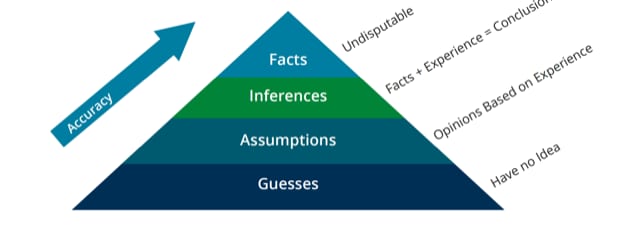How to use the RED Model to Develop Critical Thinking Skills
by

Understanding how the mind interacts with information is a key facet in helping to develop critical thinking within your organisation.
The RED Model for Developing Critical Thinking
Part two
The RED model for developing critical thinking skills is a process recommended by Pearson and TalentLens to help two things:
- Develop aptitude for critical thinking
- Improve the standard of critical thinking within your business.
Naturally, this will result in improved critical thinking test scores and pass marks, but it also helps grow your businesses thinking capabilities.
The RED critical thinking model is broken down into three core phases as part of the cognitive thinking process for when we gather and analyse information. Each phase has two core components which are broken down as follows:
Recognise Assumptions (Phase 1 of the RED Model)
Recognising assumptions is all about training the mind to gather information correctly and objectively without asserting immediate assumptions. Analysis of data and judgements come later on in the thinking process and so assumptions mustn’t be made immediately when data is gathered.
Gathering Information - Gathering information accounts for the first part of the recognising assumptions phase of the RED model. When gathered correctly, information is acquired via multiple, unbiased resources that are legitimate and true raw forms of information. In other words, they haven’t been manipulated or misinterpreted throughout the gathering process.
Information Synthesizing - Information synthesizing is how the information that has been gathered can be synthesized together to learn from the information/topic at hand. It is within this part of phase one that objective learning has to be taken into account and any unconscious biases with the information must be raised and worked around/removed.
Evaluate Arguments (Phase 2 of the RED Model)
Evaluating arguments form the overall basis for phase 2 of the RED model for developing critical thinking. The core aspect of this phase of the process is to, without bias, analyse and evaluate arguments in an objective manner that doesn’t hinder the development of the critical thinking process.
Sense Making - Sense making, while based on experience, looks to make sense of the information and arguments gathered, as clearly and objectively as possible. Again, any unconscious bias must be identified during this part of the process to not compromise the judgement. This is essentially a core component of the rationalising of the information process that flows throughout critical thinking.
Analyse and Problem Solving - Instinctively, it is in our nature when seeing a problem to immediately try to resolve it without necessarily understanding it. As part of the critical thinking process, analysing and solving problems should come later on in the process, once all the relevant information is gathered. This allows for better, more actionable and empathetic solutions for the individual and the business.
Drawing Conclusions (Phase 3 of the RED Model)
The final phase of the RED model is concluding. As you’d expect, this is where the judgements and decisions are made off the back of the information gathered and analysed throughout the first two phases of the RED model.
Judgement and Decision Making - Here it’s simple - make a judgement and a decision on how to move forward in an objective, unbiased manner. The key thing here is to remember objectivity but to also temperature check the judgement and decision with another party who can be trusted to also think critically when interpreting information.
 Strategic and Creative Thinking - Strategic and creative thinking is the final icing on the cake. Here, this is where the best critical thinkers cut their teeth. Critical and strategic thinking is when the information gathered, analysed and judged upon can be interpreted into a strategic vision for moving forward.
Strategic and Creative Thinking - Strategic and creative thinking is the final icing on the cake. Here, this is where the best critical thinkers cut their teeth. Critical and strategic thinking is when the information gathered, analysed and judged upon can be interpreted into a strategic vision for moving forward.
This involves some form of abstraction and understanding/ability to see the bigger picture, thinking beyond the initial information/stage of the thought process we are in. So strategic thinking in itself also requires some form of training and development to have a bigger impact on business growth over time.
Starting to Develop Your Teams Critical Thinking Skills
Once the RED model is interpreted and understood, it can form the basis for a company's critical thinking decisions moving forward.
Developing critical thinking skills can be improved further through the use of critical thinking exercises and general further research into the cognitive process for developing this skill set.
In short, understanding how the mind interacts with information is a key facet to help to develop critical thinking as an asset within your organisation.
To learn more about critical thinking, and the benefit that it could have to your business or organisation please check out our Critical Thinking Hub or Watson Glaser Critical Thinking Assessment. Alternatively, you can contact us if you have any other questions.

